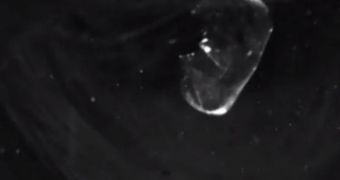A collaboration of researchers in the United States announces the creation of a new lifeform, made up of cells from another one. Using rat heart cells and silicone, the team was able to piece together an artificial jellyfish, which behaves in an extremely interesting manner.
The work was led by bioengineers at the Harvard University and the California Institute of Technology (Caltech), in Pasadena. Details of their study were published in the July 22 issue of the top scientific journal Nature Biotechnology.
Scientists used cells taken from the heart muscle of a rat to create the medusoid. The synthetic creature resembles an 8-petal flower, but it is able to swim and pulse in patterns similar to those of an actual jellyfish. Creating this thing is part of a larger effort to develop methods of growing artificial organs.
At this point, people with a defective heart or liver are put on waiting lists, and need to brave their condition until a replacement organ becomes available. Even then, they take immunosuppressive drugs, in order to prevent rejection, and this can lead to severe side-effects, if the transplant holds at all.
This is why scientists have been struggling to develop methods of building artificial organs from a patient's own stem cells for quite some time. At the same time, creating such body parts would make it easier for researchers and pharmaceutical companies to study the action of new drugs.
The purpose of the newly assembled medusoid is to figure out the “fundamental laws of muscular pumps,” the researchers say. The team was basically trying to determine whether it identified the right principles when it came to understanding these pumps.
“Morphologically, we’ve built a jellyfish. Functionally, we’ve built a jellyfish. Genetically, this thing is a rat,” Harvard University expert and lead study author, Kit Parker, explains. He adds that the medusoid only functions when placed inside an electric field.
The team was able to replicate the jellyfish by studying how it moved through water. They then grew a single layer of rat heart muscle on a patterned sheet of polydimethylsiloxane, in order to replicate the observations. The electrical waves that activated the artificial creature were very smooth.
These waves spread through the creature “like when you drop a pebble in water. It’s exactly like what you see in the heart. My bet is that to get a muscular pump, the electrical activity has got to spread as a wavefront,” Parker explains.
As soon as this research is completed, the team plans to build a similar structure using human heart cells. In the future, the work may lead to the creation of transplant organs, as well as to speeding up pharmaceutical research.

 14 DAY TRIAL //
14 DAY TRIAL //